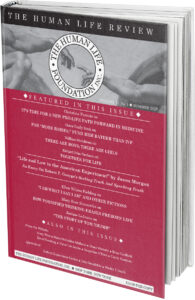THE STORY OF ABORTION IN AMERICA: A STREET-LEVEL HISTORY, 1652-2022
Marvin Olasky and Leah Savas (Crossway, 2023, 512 pp., $39.95)
Reviewed by John Grondelski
_________________________________________________________________________
Ecclesiastes advises that “there is nothing new under the sun.” Marvin Olasky and Leah Savas show that much of the history of abortion in America can be summed up as “been there, done that.” This doesn’t mean their book is boring or repetitive: In fact, it’s quite engaging. Through 50-plus chapters and over 500 pages, the writers keep the story moving, interesting, even gripping.
Most histories of abortion focus on laws and court cases. What did Blackstone mean? What drove abortion law “reform” in the late 1960s and early 1970s? Olasky and Savas examine abortion as it has been practiced. Yes, they cite the law, but often to point out how inadequately laws were enforced.
Surprised that Kermit Gosnell got away with his unregulated “house of horrors” in Philadelphia? “Madame Restell,” the abortion trade name of Anna Lohman, a leading Manhattan abortionist in the mid-1800s, avoided jail despite New York’s pro-life laws because of her largesse (read bribes) to Tammany Hall Democrats who looked the other way.
Worried that pharmaceutical abortifacients might be used to subvert state laws restricting abortion? Chemically induced abortions (usually some form of herb) preceded surgical abortions in American history. State and federal Comstock laws banning interstate commerce in abortifacients were already in place in the 1870s.
Shocked that some people tried ingesting Clorox to fight COVID? In the 1890s, some women were ingesting Lysol to induce “antiseptic” abortions. Olasky and Savas’s “street level history” demonstrates that America has always been of two minds about abortion: a visceral awareness that there was “something” wrong with the practice and a utilitarian willingness to dispose of an inconvenient pregnancy, usually one stemming from nonmarital origins. In the process, they explode myths cultivated by revisionist pro-abortion historians like Cyril Means (who played no mean role in Harry Blackmun’s twisted history of abortion in Roe) about the “abortion liberty” in this country.
Take, for example, the claim that it was not until 1821 that abortion was restricted in the United States. The authors refute this, documenting and discussing criminal cases involving abortion dating back to 1652 in Maryland. (There may even have been an earlier case in 1629 Virginia, but those records went up in smoke with the Confederate evacuation of Richmond). Nor did the 1821 Connecticut law come out of nowhere: It was enacted following a trial in which an Episcopal clergyman got a reduced sentence following a procured abortion involving a young lady to whom he had devoted particular ministrations. Again, there’s nothing new under the sun.
By the way, the Nutmeg State’s legislature was not the first legislative body in what would become the United States to proscribe abortion. That honor goes to the New York Common Council—the forerunner of today’s New York City Council—which imposed an oath on Manhattan midwives not to “counsel or administer” abortifacients in 1716.
Olasky and Savas remind readers that our understanding of human procreation only came about in the last 175 years. The female reproductive system is largely internal, mostly invisible to the eye and inaccessible in a pre-anesthesia world. That’s one reason why so much attention was attached to “quickening” as a sign of life in the womb—it was discernible. If colonial juries let off abortionists with insignificant penalties—especially if only the unborn child and not the mother died—it was because in a pre-pregnancy test/non-ultrasound world, establishing that a pregnancy existed, and then proving it was illegally terminated, largely depended on the word of the few parties directly involved. That was typically enough to bestir “reasonable doubts.”
The book makes clear that abortion cannot be seen apart from the social world in which it occurs. In colonial America, for example, the social pressures of small communities tended to protect women from irresponsible men who might engage in premarital sex and then abandon mother and child. Things changed in the early 18th century as industrialization attracted young women to towns and cities—such as the textile mills of New England or the exploding metropolis of New York—in search of work, money, and opportunities. (This was one reason, Olasky and Savas note, why YWCAs were founded.)
Nineteenth-century developments in gynecology and obstetrics led to a doctors’ movement to ban abortion, not just because the procedure was unsafe for women but because it took the life of a child. Among the book’s many lessons is that pro-life minds and hearts require a pro-life culture as well as pro-life laws—a perspective in post-Dobbs America we fail to reckon with at our peril. Olasky and Savas are uncompromisingly pro-life, but also unflinching in examining the historical record. Prolifers who are fond of quoting Santayana on the dangers of not knowing history would be wise to seek out this book.
Highly recommended.
______________________________________________________
Original Bio:
John M. Grondelski (Ph.D., Fordham) was former associate dean of the School of Theology, Seton Hall University, South Orange, New Jersey. All views expressed herein are his.









